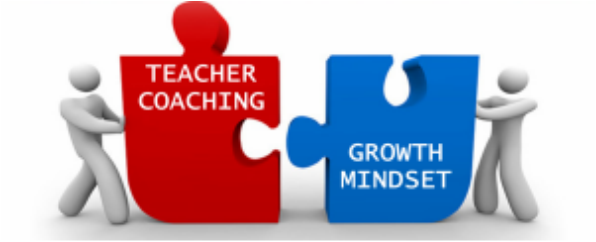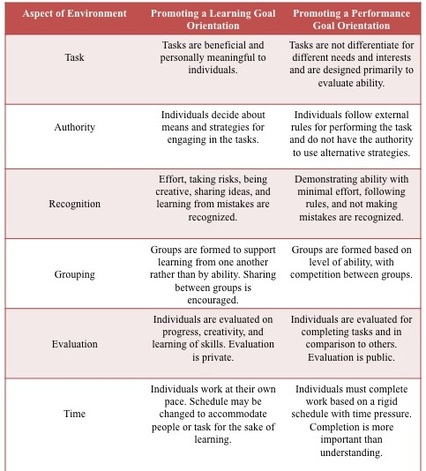
Dweck (1992) states, "....based on these findings, researchers have been able to develop ways of fostering more adaptive patterns by manipulating goal contexts or by changing individual's more chronic goal pursuit tendencies" (p. 166).
Therefore, this page of suggestions is designed for you to help you change your students' mindsets and help them adopt learning-oriented goals.
1. Let's have a look at the characteristics of a classroom environment that promotes learning goals comparing to a classroom environment that promotes performance-oriented goals. It gives ideas about what kind of tasks and activities you should have in your classroom to promote learning goals. This table can help you compare and contrast these characteristics to the characteristics of your own classroom. You can also find out what you can change about your teaching if you think there are some characteristics that promote a performance-goal orientation.
Therefore, this page of suggestions is designed for you to help you change your students' mindsets and help them adopt learning-oriented goals.
1. Let's have a look at the characteristics of a classroom environment that promotes learning goals comparing to a classroom environment that promotes performance-oriented goals. It gives ideas about what kind of tasks and activities you should have in your classroom to promote learning goals. This table can help you compare and contrast these characteristics to the characteristics of your own classroom. You can also find out what you can change about your teaching if you think there are some characteristics that promote a performance-goal orientation.
2. You can integrate activities that teach your students about goal orientation directly. They can discuss different goal orientations in class and find out theirs. In the video below, watch how a high school teacher teaches goal orientation directly.
3. In addition to discussing with your students, you can use this survey not only to assess your students' current mindsets but also your classroom(s) mindsets overall and your school's current mindset. By finding out your classroom's mindset overall, you can understand if you are somehow promoting a fixed mindset so that you can make some changes in your teaching. You can also find out if you are on the right track by promoting a growth mindset. If your school has a fixed mindset you can help them change their mindsets by the information you have gained from this tutorial.
4. You should try to create a classroom environment in which every student will want to take challenges, will know that making mistakes is a part of learning, and will have high confidence in their abilities. Below is the list of statements to communicate learning goals when you introduce a new topic or an assignment so that your students will not quit even before they try as a result of their fixed mindsets.
- New material is an opportunity to stretch!
- Today’s learning objective will give everyone an opportunity to stretch.
- Today, your brain will get stronger.
- I am hoping that you all do not know this already; I wouldn’t want to waste your time!
- I really want us to stretch beyond our comfort zone on this!
- After you do this, I’m going to ask everyone to share one mistake so we can learn from it.
- I’d like everyone to share one thing that is really confusing with their partner.
- The point of the lesson is learning; I want to know what parts are unclear so we can all meet our learning target.
- Today’s target for learning is __________________. By tomorrow our goal is ________________________.
- I do not expect you to know this already. I am here to help you learn challenging material.
- Today, I want you to challenge yourself. Stretch to learn this challenging material.
- This is very dense reading/challenging material. I am not going to hold you accountable for understanding all of it right away, but I want you to give it a first try.
- This is just the first draft—you’ll have lots of chance to improve it.
- I want you to push yourselves to tackle this concept.
- You won’t be graded on this—it’s a risk-free zone!
- We’re in the learning zone today. Mistakes are our friends.
5. Praise carries a great importance in setting mindsets. The praises that give the idea that success is due to personal abilities will result in fixed mindsets. However, the praises that suggest that success is due to effort and hard work will help students believe that with enough effort and hard work they can learn more and succeed. Therefore, another way to help your students change their mindsets is to give the right message through your praises. You should avoid person-oriented or end-oriented praise. Instead, you should praise your students for process and effort. For instance:
Use: Avoid:
"Great job! You tried very hard." "Great job! You are very smart."
"You found a really good way to do it." "You are very creative."
"You really studied for your English test, "You made an A on that test. I am so proud of your grade!"
and your improvement shows it."
You can also help your students understand that learning is more important than grades and you value their learning through challenging tasks is worth more than what their grades say. Therefore, praise can be given to completing challenging tasks rather than easy tasks. In the video on the left, you can learn some tips about praising your students with specific examples and in the video on the right, you can learn how to teach growth mindset.
|
|
|
As you have seen from the examples, the attention should always be given to students' effort and strategy use, rather than to abilities or intelligence for both success and failure. As Dweck (2005) claims, "When students fail, teachers should also give feedback about effort or strategies -- what the student did wrong and what he or she could do now. We have shown that this is a key ingredient in creating mastery-oriented students" (Education World - Wire Side Chats).
Click here to learn more about how teachers' use of praise, emphasis on grades and intelligence affect students' implicit beliefs about intelligence. Carol Dweck answers questions about teachers' attitudes and what they can do differently to change students' fixed mindsets.
6. If your students know that their intelligence can develop by effort, hard work, and effective use of strategy, it will be easier to change their fixed mindsets, motivate them, and keep them motivated and interested in challenging tasks. Aside from teaching these ideas, you can use induction activities. Here is a reading that you can use to teach them how intelligence grows stronger. This reading can be adapted to any content area or grade level and can be followed by supportive activities.
With the help of the reading, you can teach your students that
- intelligence, ability, and talent can always be improved,
- effort is necessary for intelligence, ability, and talent to improve, making mistakes are good as long as we learn from them,
- failure is not caused by intelligence, but by lack of effort and hard work.
7. You can also use analogies to teach how they can improve their intelligence. For example:
- Gym workout (‘the brain is a muscle’). Here is the follow-up activity that you can use after the reading I have shared earlier. First, you can let them talk about their memories about their experiences in learning, they can discuss what they have struggled before, yet managed to become successful, and finally how they felt about it. For example, addition was difficult when they first learned it, then it got much easier by practice.
- Learning a musical instrument,
- Learning a foreign language,
- Learning a computer game; getting stuck at a level, then finding the way up a level by persistent trial and error.
8. You can also use letters for students, class mottos, and posters that give the idea of intelligence's being malleable and how they can achieve anything they want as long as they take risks, work hard, put forth the effort the work requires, and as long as they do not give up after failures. You can find examples of letters, mottos, and posters. You can sign up for free to see the content and to get more materials or click letter, motto, and poster to download these materials on your computer.
9. Finally, you can give examples of role models and evidence. You can explain that not every artist or inventor started their careers as achievers or did not have high IQs. They also had failures, but they kept trying. Below is a good video to show them so that they know that if they put enough effort they can achieve anything they want.
Always remember
your focus should be on learning and improvement, not student performance,
your students' focus should be on the learning process, not performance in comparison to other students,
value should lie in effort and building knowledge, not high ability compared to others,
effort should be inspired by gaining new knowledge, not by high grades or outperforming others,
success should mean development and growth, not high grades or high performance comparing to others,
errors should be learning opportunities, not reasons to worry,
evaluations should be based on meeting standards and improvement, not norm-referenced in your teaching.
(adapted from the checklist on http://www.niu.edu/eteams)
It is time to discuss some scenarios that you can possibly face in your profession. We will decide about beliefs of students and teachers in the scenarios, find evidences, and hypothesize some possible solutions to change fixed mindsets. Click here to continue.


